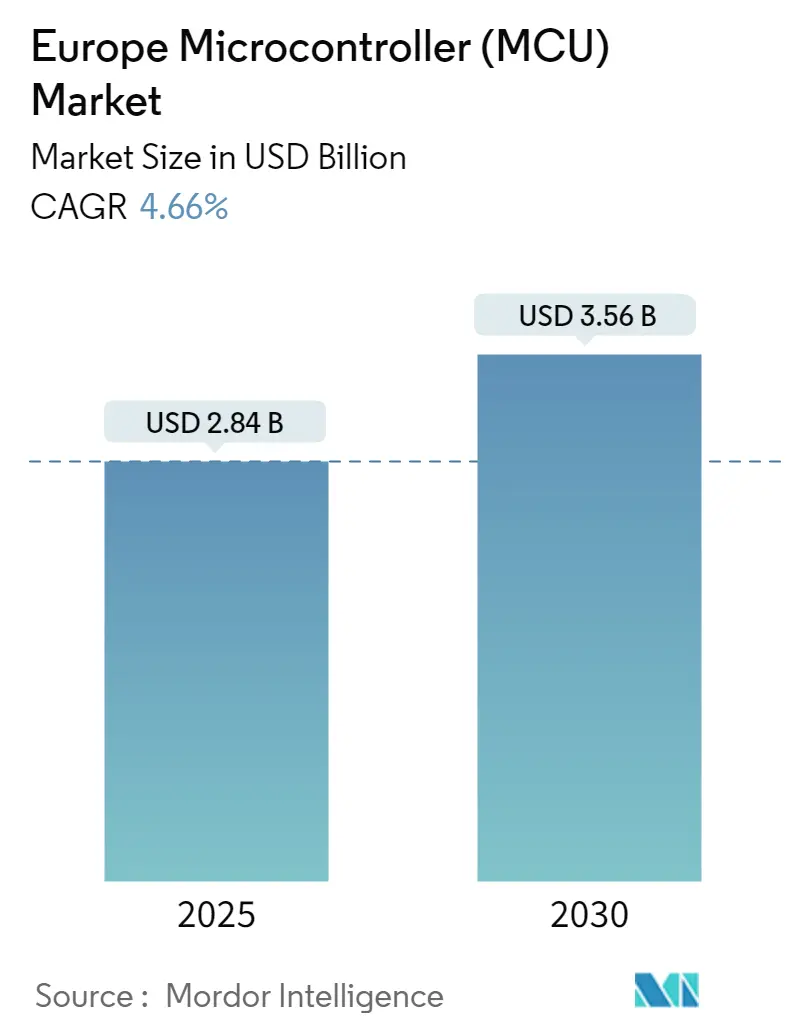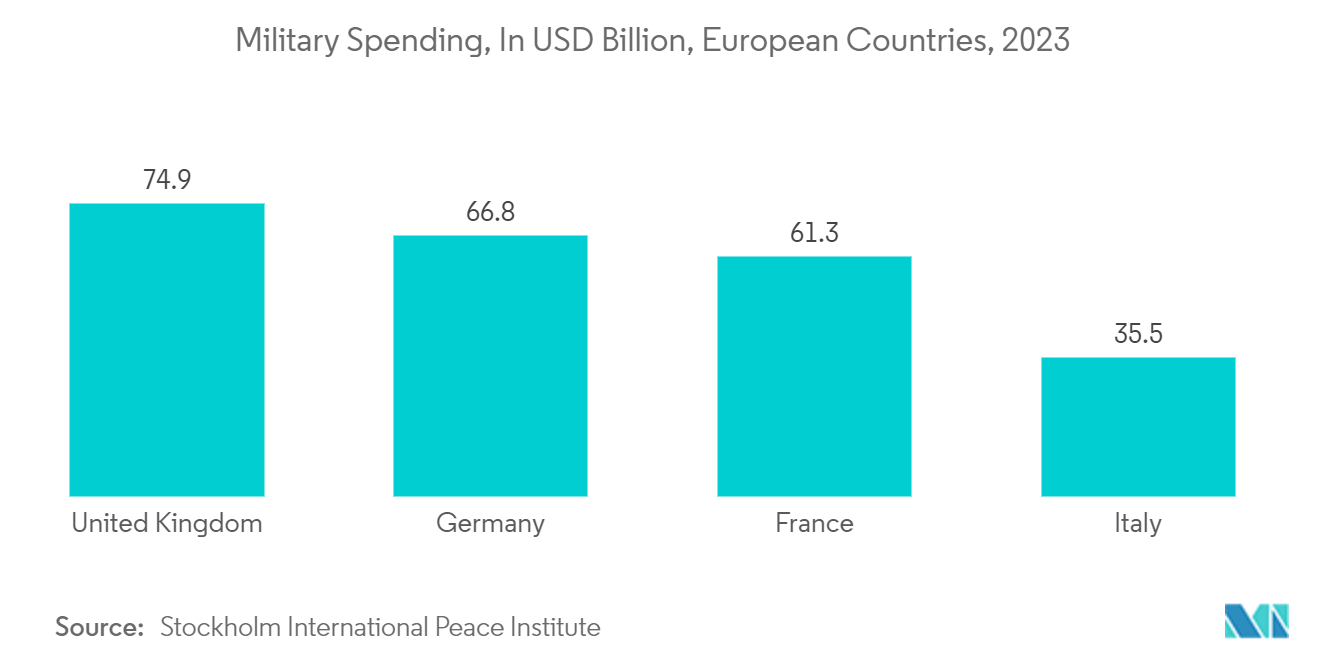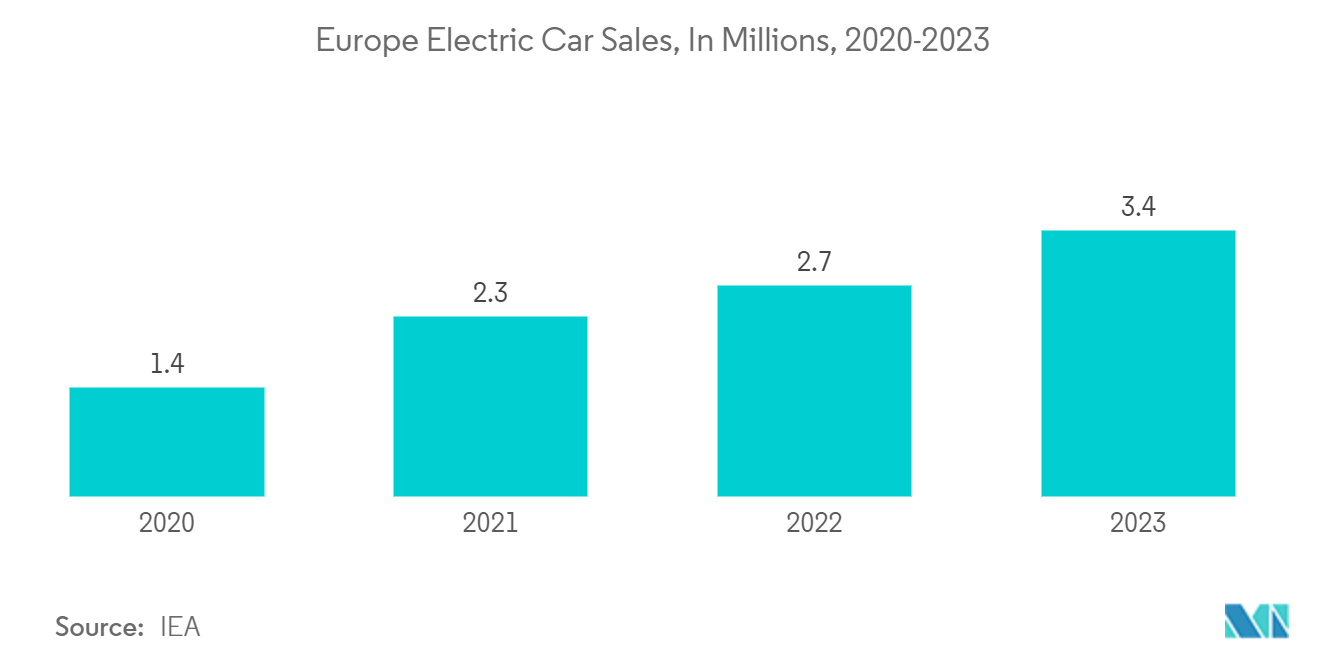Europe Microcontroller (MCU) Market Size and Share

Europe Microcontroller (MCU) Market Analysis by Mordor Intelligence
The Europe Microcontroller Market size is estimated at USD 2.84 billion in 2025, and is expected to reach USD 3.56 billion by 2030, at a CAGR of 4.66% during the forecast period (2025-2030).
The rising adoption of industrial automation and Industry 4.0 and the use of automated material handling systems such as industrial robots, COBOTs, rollers, and automated guided vehicles are fueling the demand for microcontrollers.
- High demand for hybrid and electric vehicles is anticipated to provide promising opportunities for the growth of the microcontroller industry. According to the National Automobile Manufacturers Association, Germany is the largest European plug-in electric vehicle sales market. Among European countries, German motorists purchased 681,900 plug-in electric vehicles in 2021. The development of advanced driver assistance systems (ADAS) also contributes to the development of autonomous vehicles, leading to the growth of the market studied.
- The increasing government support to increase digitization across various industries may fuel the European microcontroller (MCU) market. The Italian Ministry of Economic Development initiated the Industrial 4.0 (I4.0) National Plan, committing EUR 18 billion for the initiative. The program aims to transform traditional manufacturing methods with a focus on skills and advanced technology and support the digitization of the Italian economy. It emphasizes a future based on collaboration with other key initiatives across countries, further boosting the studied segment.
- The rising penetration rates of urbanization have increased the demand for advanced, aesthetically appealing products that can better serve consumers' requirements, such as multiple features in one device and time schedules. In addition, the vast millennial population across Europe has been quick to adopt smartwatches due to the high prices they can afford while tracking their regular work hours, further supporting market growth.
- The major factors restraining the market are the increasing complexity of MCU designs and the demand for high accuracy and precision of semiconductor devices. Microcontrollers generally have a complex structure. They cannot interface with a better power device directly. The number of executions is also limited. Microcontrollers are composed of complementary metal-oxide-semiconductor (CMOS) and can be damaged by a static charge.
Europe Microcontroller (MCU) Market Trends and Insights
Increasing Military Spending in the Region to Augment Market Growth
- Governments' increasing investments in the military and defense industry further drive the demand for microcontrollers. For instance, in March 2023, the UK government announced an investment of EUR 5 billion in defense and new long-term military spending ambition. Through this investment, the government aims to meet the challenges of an increasingly volatile and complex world.
- In April 2023, the French government announced adding EUR 1.5 billion to the 2023 annual budget defense, bringing it from EUR 43.9 billion to approximately EUR 45.4 billion. By 2030, the country's annual defense budget is expected to top EUR 60 billion, nearly double the amount allocated in 2017 (EUR 32 billion).
- According to SIPRI, military spending in Germany has increased in recent years. In 2021, it amounted to almost USD 56 billion. In July 2022, the German federal government adopted the draft of the federal budget for 2023 and the finance plan for 2022-26. The amount spent on core defense in 2023 is estimated to be EUR 50.1 billion (USD 55.4 billion), an increase of EUR 2.76 billion from the finance plan agreed in June 2021. Such a rise in military spending is expected to drive the market studied.
- Microcontrollers are widely used in the aerospace and defense industry owing to their radiation-hardened, radiation-tolerant, and high-reliability properties. These properties help in overcoming harsh environmental conditions. Microcontrollers are used to develop embedded solutions such as operating systems for aircraft control and running other safety-critical systems.
- The increasing use of sensors for capturing data for monitoring and the need for time control capabilities and high precision drive the demand for microcontrollers in the aerospace and defense industry. According to a report from the European Space Agency, microcontrollers are critical components for software-based data acquisition and simple controlling applications giving higher flexibility and autonomous capability.
- Many companies have been investing in the market to provide their customers with various solutions in the military and defense market to adapt to the changing technological needs globally. The military mainly uses InP in laser guidance systems, wireless devices for military applications, and night vision for decision-making and communications applications.

Automotive Industry May Drive the Demand for Microcontrollers
- The European microcontroller (MCU) market is witnessing high growth over the forecast period. The growth is attributed to the shift toward electric vehicles due to rising disposable income and growing concerns about environmental sustainability.
- With the growing adoption of connected and electric cars, the rapidly-progressing automotive market is set to augment the microcontrollers with demands around improved battery performance in EVs, sensors, and other related technologies. Government policies also support the adoption. For instance, the European Commission plans to have at least 30 million electric vehicles on the region's roads by the end of the decade, i.e., 2030. With the adoption of electric vehicles led by governmental efforts, the demand for microcontrollers has been increasing rapidly for features such as blind-spot detection, backup camera, and essential connectivity features.
- In addition, several EV manufacturers are setting their manufacturing sites in Europe to benefit from its efficient automotive manufacturing industry. For instance, in January 2024, NXP has launhed general-purpose microcontrollers (MCUs), based on Arm Cortex-M33. These new offerings, the NXP MCX A14x and NXP MCX A15x, are designed for a diverse set of applications, spanning industrial sensing, motor control, and IoT. Noteworthy features include a power-efficient peripheral set, a dedicated motor control subsystem, and built-in interfaces for MIPI-I3C, I2C, and SPI.
- Similarly, several manufacturers are focusing on developing innovative products for the automotive industry and gaining a competitive edge in the market. For instance, in June 2024, Infineon launched AURIX TC4x family of microcontrollers. These are optimized for zonal controllers, centralizing computing to manage various car functions, thereby meeting the industry’s shift towards zonal architectures.

Competitive Landscape
The European microcontroller market is competitive and significantly consolidated. The wide range of applications of microcontrollers contributes to intense rivalry among key market players. The major providers are in the process of the constant evolution of products, following different strategies to capture the market. The players are looking forward to strategic collaboration with other brands and joint product developments for coming up with problem-solving solutions.
- August 2022: STMicroelectronics announced the release of Version 4.20 of TouchGFX user-interface design software for microcontrollers. The updates include support for ST's new NeoChrom graphics accelerator, integrated into advanced MCUs such as the new STM32U5 series.
- May 2022: Microchip Technology released the industry's first microcontroller (MCU), combining a secure subsystem and Arm TrustZone technology in a single package. The PIC32CM LS60, which incorporates Microchip's Trust Platform secure subsystem, simplifies the development of end products by allowing the use of a single microcontroller rather than two or more semiconductor chips.
Europe Microcontroller (MCU) Industry Leaders
-
Infineon Technologies AG
-
NCP Semiconductor NV
-
Analog Device Inc.
-
Texas Instruments Incorporated
-
Microchip Technology Inc.
- *Disclaimer: Major Players sorted in no particular order
-Market---Market-Concentration.webp)
Recent Industry Developments
- May 2023: IDEX Biometrics announced the development of an advanced solution for biometric smart cards by leveraging products and technologies from STMicroelectronics. The solution integrates fully with ST's STPay-Topaz-Bio Operating technology and payment applets and combines IDEX Biometrics' biometric technology with the most recent Secure Element from ST. This high-performance solution incorporates a cost-effective enrollment method and the ST31N600 secure microcontroller with biometric features packaged in a single-chip EMV module.
- June 2022: Microchip Technology Inc. announced the AVR-IoT Cellular Mini Development Board based on the AVR128DB48 8-bit microcontroller (MCU). This solution provides a robust platform for actuator nodes and building sensors on 5G narrowband IoT networks. It is ideal for developers who want to connect IoT devices to an available 5G network.
- June 2022: Renesas Electronics Corporation announced the development of circuit technologies for 22-nm embedded STT-MRAM with faster read and write performance for microcontrollers in IoT applications. The test chip incorporates a 32-megabit (Mbit) MRAM memory cell array with a random read access time of 5.9 nanoseconds (ns) at a maximum junction temperature of 150°C, 5.8 megabytes per second (MB/S).
Europe Microcontroller (MCU) Market Report Scope
Microcontrollers are computing units that control various peripherals and embedded systems, such as domestic appliances, automobiles, robotics, industrial machinery, and other devices. A processor unit, input/output (I/O) ports, on-chip storage, wireless communication modules, and various other integrative modules can be added to the device to achieve customizable functionality.
The European microcontroller (MCU) market is segmented by type (8-bit, 16-bit, and 32-bit), application (automotive, telecommunications infrastructure, defense and aerospace, mobility, enterprise data processing, medical, consumer, smartcard and secure MCU, and industrial), and geography. The market sizes and forecasts are provided in terms of value (USD) and volume (billion units) for all the above segments.
| 8-bit |
| 16 bit |
| 32 bit |
| Aerospace and Defense |
| Consumer Electronics and Home Appliances |
| Automotive |
| Industial |
| Healthcare |
| Data Processing and Communications |
| Other Applications |
| United Kingdom |
| Germany |
| France |
| Italy |
| By Product | 8-bit |
| 16 bit | |
| 32 bit | |
| By Application | Aerospace and Defense |
| Consumer Electronics and Home Appliances | |
| Automotive | |
| Industial | |
| Healthcare | |
| Data Processing and Communications | |
| Other Applications | |
| By Geography | United Kingdom |
| Germany | |
| France | |
| Italy |
Key Questions Answered in the Report
How big is the Europe Microcontroller (MCU) Market?
The Europe Microcontroller (MCU) Market size is expected to reach USD 2.84 billion in 2025 and grow at a CAGR of 4.66% to reach USD 3.56 billion by 2030.
What is the current Europe Microcontroller (MCU) Market size?
In 2025, the Europe Microcontroller (MCU) Market size is expected to reach USD 2.84 billion.
Who are the key players in Europe Microcontroller (MCU) Market?
Infineon Technologies AG, NCP Semiconductor NV, Analog Device Inc., Texas Instruments Incorporated and Microchip Technology Inc. are the major companies operating in the Europe Microcontroller (MCU) Market.
What years does this Europe Microcontroller (MCU) Market cover, and what was the market size in 2024?
In 2024, the Europe Microcontroller (MCU) Market size was estimated at USD 2.71 billion. The report covers the Europe Microcontroller (MCU) Market historical market size for years: 2019, 2020, 2021, 2022, 2023 and 2024. The report also forecasts the Europe Microcontroller (MCU) Market size for years: 2025, 2026, 2027, 2028, 2029 and 2030.
Page last updated on:
Europe Microcontroller (MCU) Market Report
Statistics for the 2025 Europe Microcontroller (MCU) market share, size and revenue growth rate, created by Mordor Intelligence™ Industry Reports. Europe Microcontroller (MCU) analysis includes a market forecast outlook for 2025 to 2030 and historical overview. Get a sample of this industry analysis as a free report PDF download.
_Market.webp)


